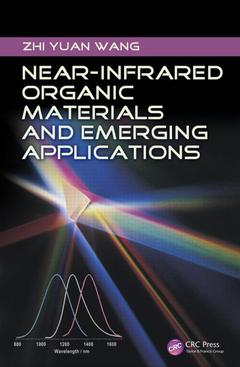Near-Infrared Organic Materials and Emerging Applications
Auteur : Wang Zhi Yuan

To physicists and chemists, color means light?emission, absorption, spectrum, and coloration. Near-Infrared Organic Materials and Emerging Applications presents knowledge and applications of invisible "colored" organic materials. Near-infrared (NIR) materials are defined as substances that interact with NIR light, namely, absorption and reflection, and emit NIR light upon stimulation, for example, photoexcitation, electric field, and chemical reaction. This book offers up-to-date information on low band-gap organic materials with unique near-infrared absorbing, fluorescent, and photovoltaic properties for various emerging applications.
The author emphasizes the chemistry of materials, in particular the structure?property relationship of near-infrared organic compounds and polymers. The text discusses the molecular design aspect of NIR materials, including effects of conjugation length and donor?acceptor charge transfer. Chapters also cover information on the structures and key properties of NIR organic compounds, such as those containing rylene, polymethine, and metal-complex chromophores, as well as polymers, including nonconjugated NIR-absorbing, conjugated dye-containing, and donor?acceptor conjugated polymers.
The final chapter describes emerging applications of NIR organic materials based on absorbing, chromogenic, photosensitizing, photovoltaic, and fluorescent properties, as well as applications of low band-gap compounds and polymers in ambipolar organic transistors. Presenting useful data and thought-provoking ideas, this book provides a practical reference on optical properties and structures of NIR organic materials and their design principles and applications.
Introduction. Molecular design and energy gap tuning. Near-infrared organic compounds. Near-infrared absorbing polymers. Emerging applications of near-infrared organic materials. Index.
Zhi Yuan (Wayne) Wang, Ph.D., is a professor of chemistry in the Department of Chemistry at Carleton University, Ottawa, Ontario, Canada and holds a Canada Research Chair in Emerging Organic Materials. Professor Wang’s research interests focus on the study and development of fundamentally important and practically useful organic materials, including nonlinear optical chromophores and polymers, near-infrared chromogenic materials, chiroptical materials, and photocurable polymers.
Date de parution : 05-2013
15.6x23.4 cm
Date de parution : 10-2019
15.6x23.4 cm
Thèmes de Near-Infrared Organic Materials and Emerging Applications :
Mots-clés :
American Chemical Society; NIR Absorption; NIR Region; Bond Length Alternation; Perylene Diimide; LUMO Level; Energy Gap; Squaric Acid; Low Band Gap; NIR Dye; NIR Fluorescent; NIR Absorber; Bathochromic Shift; Low Band Gap Polymer; Polymer Solar Cells; NIR Light; Metal Dithiolenes; Band Gap; NIR Emission; Dithiolene Complexes; BHJ Solar Cell; Polymethine Dyes; Optical Band Gap; NIR Spectral Region; Aromatic Sextets


